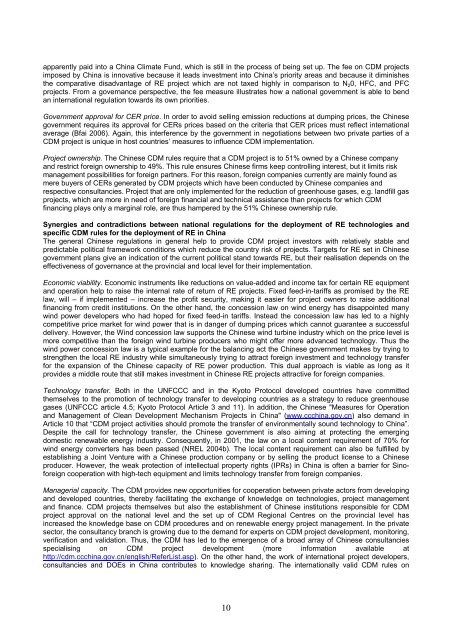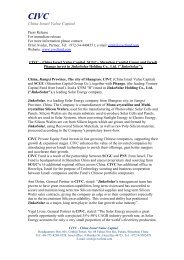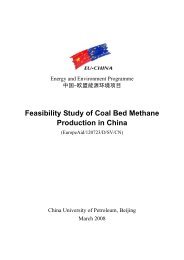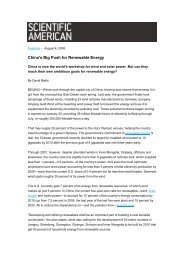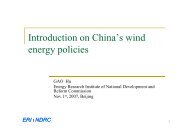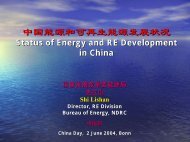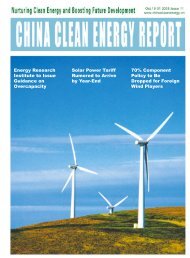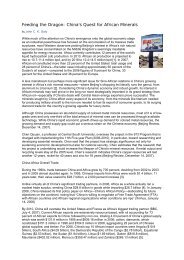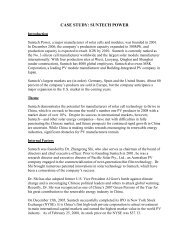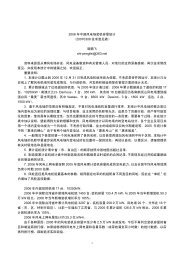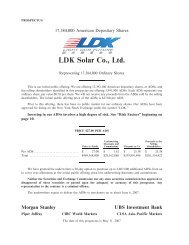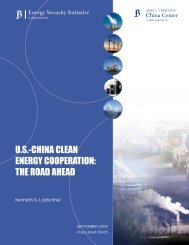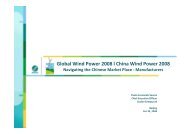20, 2007 Västerås, Sweden - Asia Europe Clean Energy (Solar ...
20, 2007 Västerås, Sweden - Asia Europe Clean Energy (Solar ...
20, 2007 Västerås, Sweden - Asia Europe Clean Energy (Solar ...
Create successful ePaper yourself
Turn your PDF publications into a flip-book with our unique Google optimized e-Paper software.
apparently paid into a China Climate Fund, which is still in the process of being set up. The fee on CDM projects<br />
imposed by China is innovative because it leads investment into China’s priority areas and because it diminishes<br />
the comparative disadvantage of RE project which are not taxed highly in comparison to N <strong>20</strong>, HFC, and PFC<br />
projects. From a governance perspective, the fee measure illustrates how a national government is able to bend<br />
an international regulation towards its own priorities.<br />
Government approval for CER price. In order to avoid selling emission reductions at dumping prices, the Chinese<br />
government requires its approval for CERs prices based on the criteria that CER prices must reflect international<br />
average (Bfai <strong>20</strong>06). Again, this interference by the government in negotiations between two private parties of a<br />
CDM project is unique in host countries’ measures to influence CDM implementation.<br />
Project ownership. The Chinese CDM rules require that a CDM project is to 51% owned by a Chinese company<br />
and restrict foreign ownership to 49%. This rule ensures Chinese firms keep controlling interest, but it limits risk<br />
management possibilities for foreign partners. For this reason, foreign companies currently are mainly found as<br />
mere buyers of CERs generated by CDM projects which have been conducted by Chinese companies and<br />
respective consultancies. Project that are only implemented for the reduction of greenhouse gases, e.g. landfill gas<br />
projects, which are more in need of foreign financial and technical assistance than projects for which CDM<br />
financing plays only a marginal role, are thus hampered by the 51% Chinese ownership rule.<br />
Synergies and contradictions between national regulations for the deployment of RE technologies and<br />
specific CDM rules for the deployment of RE in China<br />
The general Chinese regulations in general help to provide CDM project investors with relatively stable and<br />
predictable political framework conditions which reduce the country risk of projects. Targets for RE set in Chinese<br />
government plans give an indication of the current political stand towards RE, but their realisation depends on the<br />
effectiveness of governance at the provincial and local level for their implementation.<br />
Economic viability. Economic instruments like reductions on value-added and income tax for certain RE equipment<br />
and operation help to raise the internal rate of return of RE projects. Fixed feed-in-tariffs as promised by the RE<br />
law, will – if implemented – increase the profit security, making it easier for project owners to raise additional<br />
financing from credit institutions. On the other hand, the concession law on wind energy has disappointed many<br />
wind power developers who had hoped for fixed feed-in tariffs. Instead the concession law has led to a highly<br />
competitive price market for wind power that is in danger of dumping prices which cannot guarantee a successful<br />
delivery. However, the Wind concession law supports the Chinese wind turbine industry which on the price level is<br />
more competitive than the foreign wind turbine producers who might offer more advanced technology. Thus the<br />
wind power concession law is a typical example for the balancing act the Chinese government makes by trying to<br />
strengthen the local RE industry while simultaneously trying to attract foreign investment and technology transfer<br />
for the expansion of the Chinese capacity of RE power production. This dual approach is viable as long as it<br />
provides a middle route that still makes investment in Chinese RE projects attractive for foreign companies.<br />
Technology transfer. Both in the UNFCCC and in the Kyoto Protocol developed countries have committed<br />
themselves to the promotion of technology transfer to developing countries as a strategy to reduce greenhouse<br />
gases (UNFCCC article 4.5; Kyoto Protocol Article 3 and 11). In addition, the Chinese "Measures for Operation<br />
and Management of <strong>Clean</strong> Development Mechanism Projects in China" (www.ccchina.gov.cn) also demand in<br />
Article 10 that “CDM project activities should promote the transfer of environmentally sound technology to China”.<br />
Despite the call for technology transfer, the Chinese government is also aiming at protecting the emerging<br />
domestic renewable energy industry. Consequently, in <strong>20</strong>01, the law on a local content requirement of 70% for<br />
wind energy converters has been passed (NREL <strong>20</strong>04b). The local content requirement can also be fulfilled by<br />
establishing a Joint Venture with a Chinese production company or by selling the product license to a Chinese<br />
producer. However, the weak protection of intellectual property rights (IPRs) in China is often a barrier for Sinoforeign<br />
cooperation with high-tech equipment and limits technology transfer from foreign companies.<br />
Managerial capacity. The CDM provides new opportunities for cooperation between private actors from developing<br />
and developed countries, thereby facilitating the exchange of knowledge on technologies, project management<br />
and finance. CDM projects themselves but also the establishment of Chinese institutions responsible for CDM<br />
project approval on the national level and the set up of CDM Regional Centres on the provincial level has<br />
increased the knowledge base on CDM procedures and on renewable energy project management. In the private<br />
sector, the consultancy branch is growing due to the demand for experts on CDM project development, monitoring,<br />
verification and validation. Thus, the CDM has led to the emergence of a broad array of Chinese consultancies<br />
specialising on CDM project development (more information available at<br />
http://cdm.ccchina.gov.cn/english/ReferList.asp). On the other hand, the work of international project developers,<br />
consultancies and DOEs in China contributes to knowledge sharing. The internationally valid CDM rules on<br />
10


